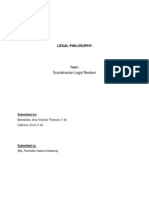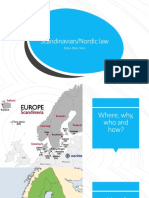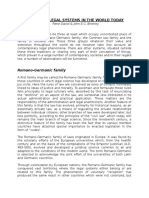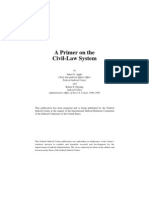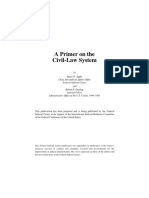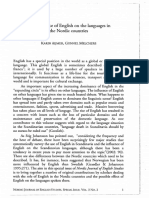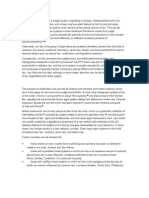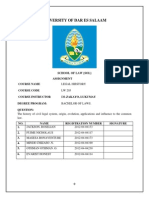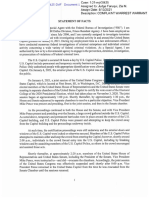What Is Scandinavian Law?: Concept, Characteristics, Future
Uploaded by
Martin TimaWhat Is Scandinavian Law?: Concept, Characteristics, Future
Uploaded by
Martin TimaWhat is Scandinavian Law?
Concept, Characteristics, Future
Ulf Bernitz
1 Scandinavian Studies in Law 50 Years ................................................. 14
2 The Themes of the Article ...................................................................... 15
3 Scandinavian or Nordic Law? Terminology and
Basic Legal Setting ................................................................................. 15
4 The Classification of Scandinavian Law Within
the Families of Legal Systems ................................................................ 17
5 The Peak and Decline of Inter-Nordic Legal Cooperation ................. 23
6 The Relation between European Legislation
and Scandinavian Legal Cooperation ................................................... 26
7 Final Conclusions .................................................................................... 28
© Stockholm Institute for Scandianvian Law 1957-2010
14 Ulf Bernitz, What is Scandinavian Law?
1 Scandinavian Studies in Law 50 Years
Scandinavian Studies in Law published its first volume fifty years ago, in 1957.
The founder of the publication and its general editor of the first 24 volumes,
until 1980, was Professor Folke Schmidt of Stockholm University, primarily
known as a pioneer in labour law and characterized by his strong international
orientation and wide interests within the field of jurisprudence. Fifty years ago,
little was published on Scandinavian law in non-Nordic languages and the
traditionally strong scholarly ties between Scandinavian and German legal
science, having had their peak in the decades around 1900, had largely been
broken since the 1930:s. In the 1950:s, Folke Schmidt was able to understand,
more clearly and earlier than most others, that there was a need to communicate
Scandinavian law and legal scholarship, including its values, development and
jurisprudential thinking, to the outside world and that English had become the
modern language of universal communication.1 Folke Schmidt was succeeded as
editor by Anders Victorin, professor of private law with labour and housing law
as specialities and wide interests within comparative law. Anders Victorin,
editor 1980 - 1993, was a disciple and close collaborator of Folke Schmidt all
the way from student years.
Scandinavian Studies in Law has always been published by the Stockholm
Institute of Scandinavian Law, attached to and supported by the Law Faculty of
Stockholm University. The Faculty was founded in 1907 and the starting up of
Scandinavian Studies in Law in 1957 was an important initiative to manifest the
fiftieth anniversary of the Faculty. Likewise, the fiftieth anniversary of
Scandinavian Studies in Law in 2007 coincides with the Centennial Jubilee of
the Stockholm Law Faculty.
Over the years Scandinavian Studies in Law has been able to establish itself
as a leading publication in its field, represented in very many law libraries the
world over. Over fifty volumes have been published, this Jubilee Volume being
No 50. Until 1993, Scandinavian Studies in Law was published as a yearbook
comprising selected articles in different areas of law. From volume 38, onwards,
the material in the series is arranged according to topic. The aggregated
collection of articles published during these fifty years in Scandinavian Studies
in Law constitutes the largest bank of information available in English on
Scandinavian Law and Scandinavian legal theory, in all over 650 articles. They
are accessible on our website, the first 37 volumes in full text.2
It has been considered appropriate to devote this volume to studies related to
a core issue from the viewpoint of the purposes and ambitions of Scandinavian
Studies in Law, namely What is Scandinavian Law?
1 To this point, see in this Volume Strömholm, S., The Scandinavians: Reluctant and
Enthusiastic Club Members and Hondius, E., Pro-active Comparative Law. The Case of
Nordic Law.
2 ”sisl.juridicum.su.se”.
© Stockholm Institute for Scandianvian Law 1957-2010
Ulf Bernitz, What is Scandinavian Law? 15
2 The Themes of the Article
Within comparative law, Scandinavian law (i.e. the law of the five Nordic
countries, Denmark, Finland, Iceland, Norway and Sweden) is generally
regarded either as a subgroup of civil law or as a legal family of its own. Roman
law has never been applied as applicable law in Scandinavia and there has been
no full reception of any other foreign legal system. There are no general civil
codes of French, German, Austrian or Italian model in the Scandinavian
countries and no plans to enact such codes exist. On the other hand, statutory
law constitutes the basis in most fields of law.
Since long, there has been close legislative cooperation between the Nordic
countries, in particular in core private law areas, such as the law of contracts,
sales and torts, but also in, e. g., maritime law and intellectual property law. In
jurisprudence and academic legal writing one can discern a kind of Scandinavian
school. All this is a reflection within the law of the overall tradition of
cooperation between the Nordic states and their common historic, linguistic and
cultural heritage.
This being said, it is open to discussion how special Scandinavian law really
is. Does it merit a position as a particular group of law? In recent years inter-
Scandinavian legislative cooperation has lost most of its former impetus.
European law, both in the sense of EU law and the European Convention on
Human Rights, is playing an ever growing role and there is a strong international
influence in commercial law. In this area, the global and expanding English and
American law firms are setting their mark.
The basic theme of this article is to present in short Scandinavian law, its
position in a comparative law perspective and some of its basic features. Against
this background, I will discuss the relation between the ongoing development of
European legislation and Scandinavian law and some of the major Scandinavian
concerns in this regard.
3 Scandinavian or Nordic Law? Terminology and Basic Legal
Setting
What is really meant by Scandinavian law? The choice of terminology is not
given, the alternative being the term Nordic law.
In a strictly geographical sense, Scandinavia means the Scandinavian
peninsula, situated between the Atlantic Ocean and the Baltic Sea. In that sense,
only Norway and Sweden and the northernmost part of Finland would constitute
Scandinavia. However, in a more general sense it is obvious that also Denmark
belongs to Scandinavia, albeit the Jutland peninsula forms part of the European
mainland. Finland is by history and culture firmly a Nordic country. So are also
Iceland and the Faroe islands. Greenland is geographically regarded as part of
the American continent but also by history and culture primarily a part of the
Nordic region.
This region is most commonly referred to as the Nordic countries and, thus,
the term Nordic law would be most appropriate. However, internationally the
© Stockholm Institute for Scandianvian Law 1957-2010
16 Ulf Bernitz, What is Scandinavian Law?
term Scandinavian law is most commonly used. It was also the term chosen by
Folke Schmidt when founding Scandinavian Studies in Law and I will stick to
that term.
As well-known, within the region there are five independent countries:
Denmark, Finland, Iceland, Norway and Sweden and three territories with a high
degree of internal self-goverance: The Faroe Islands, Greenland and the Åland
Islands; the first two under Danish sovereignty and the latter under Finnish.
The Nordic countries share a common culture and heritage, based on
common democratic and social values, nowadays also the welfare state. It is of
importance that the Danish, Norwegian and Swedish languages are so closely
related that they are largely understood in the other countries. Swedish is official
language in Finland and Swedish is normally understood and many times
practiced within the Finnish legal community, albeit Finnish is by far the
dominating language. Likewise, Danish is normally understood in Iceland. This
has been an important prerequisite for the successful cooperation on legal
matters.
From a legal perspective, the Nordic countries and territories can be divided
into an East Scandinavian and a West Scandinavian group; the former
comprising Finland and Sweden (and the Åland Islands) and the latter Denmark,
Iceland, Norway (and the Faroe Islands and Greenland). The explanation is
historic.
Sweden and Finland were until 1809 one country with a centralized
governmental structure. When Finland was separated from Sweden in 1809 and
made a Grand Duchy under Russian rule, it was permitted to keep its legal
system (which was fully identical with the Swedish one). Finland succeeded to
maintain its legal independence under more than 100 years under the rule of the
Russian tsars (until 1918) and the tradition of close legal cooperation with
Sweden has largely been maintained.
Norway was from the late middle ages until 1814 in a union with Denmark
which was heavily dominated by the Danish kings ruling from Copenhagen,
something that brought about a high degree of legal and cultural uniformity
between Denmark and Norway. In 1814, Norway declared itself independent but
was forced into a looser kind of union with Sweden that lasted until 1905.
However, that union had little or no effect on Norwegian law, apart from certain
aspects of constitutional law.
Iceland, finally, was under Danish rule and (on the whole) Danish law for
many centuries until it declared itself fully independent in 1944. Also modern
Icelandic law is normally particularly close to Danish law.
All the Nordic countries have advanced social market economies and a
distinct international, free trade orientation. The economy is to a large extent
based on a number of large companies working globally. However, as is well-
known, the Nordic countries have taken different positions in relation to
European integration. Denmark entered the EU in 1973 and Finland and Sweden
followed in 1995. In Norway, a slight majority of the voters have rejected EU
membership twice (in referenda held in 1972 and 1994), opposing the intentions
of the majority of the Norwegian establishment. Norway and Iceland have
chosen to stay as EFTA countries within the EEA (European Economic Area)
for the time being. The Åland islands joined the EU in 1995 together with the
© Stockholm Institute for Scandianvian Law 1957-2010
Ulf Bernitz, What is Scandinavian Law? 17
rest of Finland after having had a referendum of its own. The Faroe Islands and
Greenland do not belong to the EU.
The EEA appears to remain a more permanent solution than was first
thought. However, Iceland and Norway have to adopt most of the EU directives
under the far reaching EEA Agreement, as these normally have a relation to the
internal market. In spite of this, Iceland and Norway are kept totally outside the
EU institutional framework, the preparation of EU legislation included. It is
certainly a problem for the position of Scandinavian law within the larger EU
legal cooperation that the Nordic countries cannot form a coherent group. The
Norwegian voice is largely missing in the EU legal discourse.
Today, there is a growing and quite important cooperation between the
Nordic and the Baltic countries, not least in EU related matters. However, there
is no common legal tradition in relation to the latter. It is true that Estonia was
under Swedish rule from 1558 – 1721 and most of Latvia (incl. the city of Riga)
from approx. 1630 – 1721, but Swedish law was not introduced during that time.
In 1721, Estonia and the Swedish parts of Latvia came under Russian rule.
Lithuania, on the other hand, has strong historic links to Poland. In the Baltic
countries the old Roman/Germanic legal tradition has been predominant and
partially able to survive centuries of Russian dominance. It has formed a basis
for modern codifications in the independent Baltic republics, e.g. the admirable
new Estonian civil code.
4 The Classification of Scandinavian Law Within the Families of
Legal Systems
The legal similarity between the Nordic countries is often taken for granted,
even though it has been only sparingly analyzed. It has not been subjected, for
example, to any extensive or exhaustive analysis from the point of view of
comparative law by Scandinavian legal scholars. E.g., to my knowledge not a
single doctoral treatise exists dealing with these issues. New scholarly contri-
butions in this area would certainly be welcome. The available material shows
that reports and discussions taking place at the institutionalized Meetings of
Nordic Jurists, held every third year for over 100 years, has played a major role
in this context. The centre of attention has been focused on cooperation in the
preparation of new legislation, which, although certainly of paramount
importance, does not give the whole picture.
What is of decisive importance for the scope of legal similarity between
countries is the degree of congruity between the fundamental premises of their
legal theory, consistency in the formation of their basic legal concepts, affinity
in their methodology of codification, the doctrine of precedent, the working of
the courts and the choice of the sources of law. These elements should not be
judged by the narrow perception of the differences that doubtlessly exist, but
rather from the point of view of the way in which other legal systems, such as
for example, the English, German or French systems, handle equivalent issues.
Viewed in this way, the Nordic countries are remarkably similar to each other as
© Stockholm Institute for Scandianvian Law 1957-2010
18 Ulf Bernitz, What is Scandinavian Law?
regards the fundamental perception of the legal system, its design, methodology
and basic principles.3
If we, as a concrete example, take a well-known book on legal theory and the
method to apply legal sources, e.g. the Norwegian legal scholar’s Torstein
Eckhoff’s highly valued work Rettskildelære4 (The Sources of Law), it is clear
that even though the main subject of this work is Norwegian law, most of what
is said also applies to Swedish law, even though a Swedish lawyer might have
placed the emphasis somewhat differently on occasion. A similar situation
would apply also in relation to Danish or Finnish law. If, on the other hand, a
comparative study should be made between Swedish law and the use of legal
sources in German, French or English law, important differences would certainly
be evident. On the whole, the ease with which legal doctrine is cited and applied
cross-boarder within the Nordic countries indicates clearly that their legal
similarity is actually quite deep-seated.
In this context it may be interesting to investigate the position of
Scandinavian law, as it is perceived in the framework of the division into legal
families, which has been developed in the field of comparative law.5 On this
point, scholars have presented somewhat different views. It should be pointed
out from the outset that the classification of legal systems certainly is no exact
science, it depends to a high degree on the underlying purposes and what parts of
the law which are in focus. Often, most attention has been paid to the core parts
of private law, e.g., the law of contracts and torts.
Åke Malmström, a law professor at Uppsala University and Scandinavian
pioneer in the field of comparative law, presented a classification of legal
systems (Rättsordningarnas system) in Festschrift in honour of Håkan Nial
(1966).6 Malmström reviews the existing classifications of legal systems and
legal families. He comes to the conclusion that within the Western (European–
American) legal group four legal families can be distinguished: the legal systems
of Continental Europe (with a German and a Romanistic subgroup), the Latin–
American system, the Nordic (Scandinavian) system and the Common Law
system.7 Like many other authors of the time, Malmström’s classification also
lists a group embracing the legal systems of the socialist (communist) countries.
Malmström views the Nordic legal family as being positioned laterally in rela-
tion to the systems of Continental Europe and the Common Law systems, and
3 Same opinion, Wilhelmsson, T. Den nordiska rättsgemenskapen och rättskälleläran,
Tidsskrift for Rettsvitenskap (TfR) 1985, pp.181 ff.
4 Eckhoff, T. Rettskildelære, Oslo 1971 (and many later editions).
5 For an overview of the issue, Derlén, M., A Castle in the Air. The Complexity of the
Multilingual Interpretation of European Community Law, dissertation, Departement of Law,
Umeå University, 2007 p 53 ff. See also the article by Ewould Hondius in this Volume, Pro-
Active Comparative Law: The Case of Nordic Law.
6 Malmström, Å. Rättsordningarnas system. Några synpunkter på ett klassifikationsproblem
inom den jämförande rättsvetenskapen. Festskrift till Håkan Nial. Stockholm 1966, pp. 368
ff. Malmström’s investigation has been published also in English: The System of Legal
Systems. Notes on a Problem of Classification in Comparative Law, 13 Scandinavian
Studies in Law, 1969, pp. 127 ff.
7 Malmström, op. cit., pp. 401 ff.
© Stockholm Institute for Scandianvian Law 1957-2010
Ulf Bernitz, What is Scandinavian Law? 19
therefore located at the same level as the latter ones. Thus, Malmström regards
the differences between Nordic and Continental Law as more significant than the
differences between German and Romanistic law.
In their well-known textbook “An Introduction to Comparative Law”8
Zweigert and Kötz construct a taxonomy based on the division into the
following “legal families of the world”: the Romanistic legal family (based on
the French Civil Code), the Germanic legal family (Germany, Austria,
Switzerland), the Anglo–American legal family, the Nordic legal family, the
socialist legal family and other legal families (The Far Eastern legal family,
Islamic law, Hindu law)
Zweigert and Kötz share Malmström’s point of view on Scandinavian law
and state Nordic law should be seen as a separate legal family on the highest
level.9 The authors´ motivation is worth citing:
“Nordic legal science... has always paid attention to events on the continent,
and in the nineteenth century it unquestionably got its legal wares from the
pandectists’ shop. But the tendency to undue conceptualism and the construction
of large–scale integrated theoretical systems has never really been followed in
the North, thanks to the realism of the Scandinavian lawyers and their sound
sense of what is useful and necessary in practice. Thus while the Scandinavian
legal systems have participated in the legal development of Continental Europe
they have also maintained their local characteristics, and this justifies us in
allocating them to a special Nordic group within the Civil Law.”10
Zweigert and Kötz suggest yet other reasons for incorporating Nordic law
into a separate legal family, and that is the less intensive influence of Roman law
upon Nordic law, as well as the lack in Nordic law of large, systematically
constructed private law codifications. They also point out another characteristic
feature of importance, not only as regards the area of private law. The use of all–
embracing legal principles plays a more limited role in Nordic law than in, for
example, French or German law. Instead, frequent use is made of analogies
taken from available legislation, particularly within the law of obligations. They
also mention the Nordic system´s “refreshing lack of dogma”.11
In recent Scandinavian legal writing, the topic of legal classification has
been treated, i.a., by Michael Bogdan, professor at Lund University, in his
textbook Komparativ rättskunskap12 (Comparative Legal Science). Similarly to
Professor Jacob Sundberg of Stockholm University,13 Bogdan stresses that
8 Zweigert, K. & Kötz, H., ed. Introduction to Comparative Law. 3rd revised ed., Oxford
1998.
9 The same position was taken by Arminjon, P – Nolde, B & Wolff, M, Traité de droit
comparé I, Paris 1950 p 49 ff. They distinguished between seven legal systems: the French,
German, Scandinavian, English, Russian, Islamic and Hindu.
10 Zweigert, K. & Kötz, H., op. cit., p 285.
11 Op cit p 41.
12 Bogdan, M. Komparativ rättskunskap, 2 ed, Lund 2003 p 82 f.
13 Sundberg, J. Civil Law, Common Law and the Scandinavians, 13 Scandinavian Studies in
Law, 1969, pp. 179 ff. See also Gomard, B., Civil Law, Common Law and Scandinavian
Law, 5 Scandinavian Studies in Law, 1961, pp 27 ff.
© Stockholm Institute for Scandianvian Law 1957-2010
20 Ulf Bernitz, What is Scandinavian Law?
Nordic law belongs primarily to the family of the legal systems of Continental
Europe, showing far more similarities to these systems than to those belonging
to the common law family. On the other hand, Ditlev Tamm, a Danish professor
of legal history, has favoured the view Scandinavian law should be regarded as a
separate legal family, pointing at three key factors: the limited importance of
legal formalities, the lack of modern codifications and the absence of an actual
reception of Roman law.14
As mentioned, there are no general civil codes in the Nordic countries. The
idea of creating a comprehensive code of private law has not been on the agenda
for a very long time. In Sweden, a high-quality proposal for such a code,
partially inspired by the French Code Civil and prepared during a very long
time, finally failed to win the approval of the Swedish Parliament in the midst of
the nineteenth century; it was found too modern. Had the code been approved,
Swedish and perhaps Scandinavian legal history would have taken another
course. At least since the 1880:s no major code project of this type has been on
the agenda. The situation in the other Nordic countries is largely similar. After
the Second World War, a Danish legal scholar, Professor Fredrik Vinding Kruse
presented a proposal of his own for a common Scandinavian Civil Code.15
However, this project was hardly taken seriously.
For the comparison between Scandinavian law and Continental legal systems
the Nordic attitude towards codification is a very important factor. In the Nordic
countries there are a number of acts (statutes) on different aspects of private law.
Some of these acts cover important, basic parts of the private law but they do not
cover all parts of the field and are not intended to be complete. Legal problems
which are not covered by a specific statutory provision are often solved by
applying by analogy principles expressed in the statutes or by supplementing
case law. In the uncodified or only insufficiently codified areas legal doctrine
plays an important role. A special feature of Nordic legislation is the importance
normally attached to the preparatory legislative material (traveaux
préparatoires) to major statutes. The preparatory legislative material, primarily
the Government Bills to Parliament proposing the legislation, often contain
detailed explanations of the way the different provisions within the proposed
statute are to be understood and interpreted. Normally, the courts are inclined to
attach great importance to the interpretations recommended in the preparatory
legislative material, although these are never binding in a legal sense.16 This is
particularly so in relation to well-prepared modern statutes. On the other hand,
as time goes by preparatory legislative material tends to loose in importance.
There is a special Contracts Act in force in all the five Nordic countries as a
result of early Scandinavian legislative cooperation, largely uniform. The
14 Tamm, D., The Nordic Legal Tradition in European Context, in Letto-Vanamo, P (ed),
Nordisk identitet – Nordisk rätt i europeisk gemenskap, published by KATTI, Institute for
International Economic Law at Helsinki University, 1998 p 15 ff.
15 English version: F Vinding Kruse, A Nordic Draft Code for Denmark, Finland, Iceland,
Norway and Sweden, Copenhagen 1963. The Danish version was published in 1948.
16 For an explanation in English of the preparatory legislative material as a legal source, see
e.g. Vogel, H-H, Sources of Swedish Law in Bogdan, M. (ed.), Swedish Law in the New
Millenium, Stockholm 2000 p 57 ff.
© Stockholm Institute for Scandianvian Law 1957-2010
Ulf Bernitz, What is Scandinavian Law? 21
Contracts Act was drafted in the first decades of the last century and took legal
force in Sweden, Denmark and Norway around 1915, in Finland a decade later.
There has been only one major revision; the inclusion in the mid 1970s and early
1980s of a general clause (Section 36 of the Act) making it possible to set aside
or mitigate unreasonable contract terms, in particular in consumer contracts.17
However, the Act does not cover all aspects of contract law. The first part deals
with formation by offer and acceptance, the second concerns authority to
contract and the third is on invalidity of contracts and unfair terms. Other aspects
of contract law, e.g. interpretation of contracts, are left to case law. As the
Contract Act is quite old and its provisions leave many legal issues unanswered,
case law is the primary source of law within the Scandinavian law of contracts.
In the first part of this Volume, Scandinavian contract law is treated
primarily in the critical article by Christina Ramberg.18 It is evident the existing
Contracts Acts are outdated, save for the general clause inserted in the 1970s and
early 1980s. In Kjell Åke Modéer’s contribution, the Contract Act is even
characterized as a “dead corpse”.19 However, the contract law as applied by the
courts and treated in legal doctrine is still remarkably similar in the five Nordic
countries. In a doctoral thesis by Claes-R von Post, a comparative study was
made of the application of the new general clause by the courts in Denmark,
Finland, Norway and Sweden during the years 1976 – 1999.20 He reaches the
well-founded conclusion the application of the general clause has developed
very similarly in the four countries. As another example, in a recent,
comprehensive treatise by Juri Monokka on Contractual Duty of Loyalty,21 this
emerging principle of contract law has been studied using much material from
the other Nordic countries. Also here, there are no real differences between the
legal positions taken in the Nordic countries.
Another act of special importance is the Sale of Goods Act. In 1905-07
Sweden, Denmark and Norway had enacted practically identical sale of goods
Acts, later enacted also in Finland. This Act was considered a great achievement,
was carefully studied in the law schools and widely used by analogy. However,
later adjustments to international development, primarily the 1980 United
Nations Convention on International Sales of Goods (CISG), have been less
successful. This development is described and discussed in Jan Ramberg´s
article in this Volume, The Vanishing Scandinavian Sales Law. While Finland,
17 Bernitz, U., The General Clause on Unfair Contract Terms and the Protection of the Small
Businessman, in Bernitz, European Law in Sweden – its Implementation and Role in Market
and Consumer Law, Stockholm 2002 p 241 ff (Faculty of Law, Stockholm University Series
of Publications No 70).
18 Ramberg, C., The Hidden Secrets of Scandinavian Contract Law.
19 Modéer, K Å., Harmonization or Separation? Deep Structures in Nordic Legal Cultures.
20 von Post, Claes-R, Studier kring 36 § avtalslagen med inriktning på rent kommersiella
förhållanden, Jure AB, Stockholm 1999.
21 Monokka, J, Kontraktuell lojalitetsplikt, Stockholm 2007. It may be remarked, Monokka has
been able to read and evaluate also the material in the Finnish language. Normally, for
language reasons, jurists in the other Nordic countries have to stick to the often rather
meagre material on Finnish law available in Swedish.
© Stockholm Institute for Scandianvian Law 1957-2010
22 Ulf Bernitz, What is Scandinavian Law?
Norway and Sweden enacted new Sale of Goods Acts around 1990 in order to
adjust the domestic sales law regime to the CISG,22 Denmark has kept its old
Sale of Goods Act of 1906 in force. As explained by Jan Ramberg, the Nordic
states made reservations against the CISG in respect both of the provisions on
formation of contract and its applicability to sales between the Nordic countries.
In retrospect, both these decisions, taken in order to maintain the existing
Scandinavian contract and sales law, are highly questionable. Had the issue
come up today for decision, it seems likely the international CISG solutions
would have been favoured.23 However, it was not known in 1990 that Denmark
would pull out of the Scandinavian sales law reform work. As Jan Ramberg also
points out, neither the decision to introduce in the new sales acts provisions
differing from the CISG rules on liability for loss as a consequence of breach of
contract (based on a distinction between direct and indirect losses) has become a
success. The distinction is much criticized and has not been accepted in the very
widespread standard contract forms within business.
There are special Acts on Torts (damage laws) in the Nordic countries (in
Sweden of 1972).24 In a most interesting article in this Volume Christian von
Bar is discussing this field, Non-Contractual Obligations in the Nordic countries:
a European´s Perspective. He comes to the conclusion the Scandinavian law of
non-contractual liability for damage shows some distinctive particularities which
are only to be found in this legal family.25 I.a., he points at the insurance based
solutions and the great emphasis on safeguarding basic risks, doing justice in the
particular case and protection of the weak and vulnerable in society. He also
notes that from his perspective the legislation is incomplete in different ways
and that there is a breath of variation within Scandinavia when it comes to the
response to particular problems. All these observations describe well the
structure of Scandinavian tort law.
As a complement to the specific acts within the field of private law
Scandinavian law also recognizes uncodified general principles of contract law
(the law of obligations). These principles follow primarily from case law and
have been further explored and refined in legal writing (the doctrine).26 E.g., the
principle mentioned on duty to observe loyalty in contractual relations
constitutes such an uncodified general principle. As has been observed in von
22 For an overview from the perspective of Swedish law, see, e.g., Hultmark (now Ramberg),
C, Obligations, Contracts and Sales in Swedish law in the New Millenium p 273 ff.
23 This means, taking Sweden as example, that according to the Swedish 1987 Act on
International Sales of Goods, CISG is applicable as law in Sweden, with the exception of
Articles 14-24 on Conclusion of contracts, on sales between parties in Sweden and all those
non-Scandinavian countries that have ratified the Convention.
24 Overview from Swedish perspective, Bengtsson, B., Torts and Insurance Law in Swedish
Law in the New Millenium p 299 ff.
25 It is worth noting von Bar leaves Norwegian law complete aside. This is certainly fully
explainable from a European Union perspective but strange from the perspective of
Scandinavian law. This is a striking example of the Norwegian voice missing in the EU
legal discourse owing to Norway´s EEA membership.
26 See in particular the article in this Volume by Viggo Hagstrøm, The Scandinavian Law of
Obligations.
© Stockholm Institute for Scandianvian Law 1957-2010
Ulf Bernitz, What is Scandinavian Law? 23
Bar´s article, negotiorum gestio (management of another´s affairs) and unjust
enrichment are other examples of uncodified parts of Scandinavian law of
obligations.
Thus, case law is an important and partially predominant source of law
within Scandinavian private law. However, within commercial law reported case
law often tends to be fairly scarce. In practice, legal doctrine, particularly
established text-books and commentaries, play an important and much used role
as supplementary source of law. In the Nordic countries, commercial disputes
are solved by arbitration to a very high degree and, thus, there is a certain
drought of commercial law cases decided by the ordinary courts. Arbitration
awards are very seldom reported and normally kept secret. In practice, Swedish
or other Scandinavian law is often referred to as applicable law in international
commercial contracts subject to dispute solving by arbitration. In particular, this
is the case in relation to contracts between parties in Western Europe and parties
in the former Soviet Union countries and China.
The specific features of Scandinavian law within many other fields of law
will not be described in this article but have been described and commented
upon in a number of other articles in this Volume, dealing with, i.a., maritime
law, labour law, family law, insurance law and governance of the judiciary.27
5 The Peak and Decline of Inter-Nordic Legal Cooperation
Traditionally, the driving force behind Nordic cooperation in the area of law has
been a desire to achieve similar, preferably identical legislation in all the Nordic
countries in central areas of law.28 The work has been conducted chiefly within
the Ministries of Justice of the Nordic Countries, and aimed at bringing about
permanent, high–quality statutes. The work has been performed by highly–
qualified, learned jurists (primarily qualified judges and legal scholars) in a spirit
of confidentiality and cooperation, far away from the political conflicts of the
day. Cooperation in the field of legislation has been given a legal basis, albeit
rather vague, in the form of the Helsinki Agreement – the general inter-Nordic
agreement on cooperation – signed in 1962.29
27 See, in particular, Gorton, L., Nordic Law in the Early 21st Century – Maritime Law,
Nielsen, R., EU Public Procurement Law and Nordic Labour Law – Recent Developments
and Future Challenges, Scherpe, J., The Nordic Countries in the Vanguard of European
Family Law, Beale, H. & Khanom, H., What is Scandinavian Law? English Lawyers Look at
Swedish and Norwegian Insurance Law, Bell, J., Sweden´s Contribution to Governance of
the Judiciary.
28 The issues discussed in this section of the article have been treated more fully in Bernitz, U.,
Nordic Legislative Cooperation in the New Europe, 39 Scandinavian Studies in Law 2000 p
29 ff. In Scandinavian languages, Nordiskt lagstiftningsarbete i det nya Europa (eds Bernitz,
U., Wiklund, O.) Stockholm 1996 (Skrifter utgivna av juridiska fakulteten vid Stockholms
universitet no. 48).
29 See, on the Helsinki Agreement and information about the Nordic Institutions the website
“www.norden.org”, click English.
© Stockholm Institute for Scandianvian Law 1957-2010
24 Ulf Bernitz, What is Scandinavian Law?
The substantial rules of this Agreement outline the main principles of
cooperation between the five Nordic countries in the legal, cultural, social and
economic areas, as well as in the area of communications – mostly through
general provisions that do not include clear obligations. As regards the field of
law, Art. 2 of the Helsinki Agreement stipulates that:
“Enactment of laws and other types of legal rules in any Nordic country shall
follow the principle stating that the citizens of the other Nordic countries shall be
treated on a par with the country’s own citizens. The above shall apply in the
territories embraced by the Agreement.”
Exceptions with regard to the first paragraph can be made, however, if citi-
zenship is constitutionally required, being necessary due to other international
commitments, or, when owing to special reasons, it is generally considered as
necessary.
It is further stipulated that the contracting parties shall continue legislative
cooperation in order to attain the greatest possible uniformity in private law, that
they shall strive to make uniform provisions regarding crime and its legal
consequences, and try to achieve mutual coordination of other types of
legislation in any fields deemed as appropriate. The contracting parties shall
furthermore work to provide that rulings of any court or other authority in
another Nordic country shall be executed also within the territory of the said
party (Art. 4–7).30
The actual cooperation in the legislative field has been conducted mainly in
the form of rather informal, continuous contacts and meetings between
respective ministries and legislative committees currently in progress. The
common legal texts resulting from these efforts have normally been finalized
separately in each country. Even though the Helsinki Agreement is a binding
document from the point of view of public international law, its formulations are
vague and it has usually been the interest in the subject matter and the good
intentions of all involved that has constituted the pillars of cooperation and
brought about the results.
The main result of the Nordic cooperation in the legislative field is the
general conformity that has been achieved throughout the years in such areas as
sale of goods, instruments of debt, the law of contract, tort law, etc. On the other
hand, similar cooperation has never sprung up in the area of property law. Other
important areas of inter-Nordic legal cooperation can be found within family
law, maritime law, intellectual property law and company law. In general, the
areas chosen for legal cooperation are found among those lying somewhat
outside politically sensitive matters, and where new legislation has been
expected to be long-lasting. Its guiding spirit has been long-term cooperation in
the field of law, weakly bound to specific obligations, but focused rather on the
production of common but not necessarily uniform legislation within central
legal areas, primarily within the private law.
The golden age of Nordic legal cooperation is associated especially with the
1950’s and 1960’s, even though some of the initiatives then taken and the
foundation work done in that period bore fruit only later on. At that time a
30 Nowadays, this task has largely been overtaken by EU and EEA law, i.e. the Brussels
Regulations and the Rome and Lugano Conventions.
© Stockholm Institute for Scandianvian Law 1957-2010
Ulf Bernitz, What is Scandinavian Law? 25
number of highly advanced legislative products were generated in various
important areas of law by legislative committees set up simultaneously in
Denmark, Finland, Norway and Sweden, working on a long-term basis.
Codification included, among other areas, tort law, company law and almost all
of intellectual property law.
Already the 1970s and 1980s marked a decline in Nordic legal cooperation.
Eager politicians complained about Nordic legal cooperation procedures being
unnecessarily protracted and cumbersome, and staked out each county´s right to
lead the way, acting as a groundbreaker and pioneer among the Nordic countries.
The prime representative of this policy was the Swedish social democratic
lawyer and politician Carl Lidbom, a close collaborator to Olof Palme, for many
years Sweden´s prime minister. As a result, Nordic legal cooperation became
less ambitious and far more tolerant towards national deviations. In the 1990s
and during this decade the watering-down of the inter-Nordic ambitions in the
area of legislative cooperation has become even more visible. The fact that
Nordic legal cooperation never has had, and still does not have, any fixed
regulatory system, and has been dependent primarily on the good intentions of
the responsible legislators within each country, has made this cooperation
especially vulnerable.
In this respect, the new Company Acts in the Nordic countries are real low-
water marks. In the 1970s, the Nordic countries succeeded to draft and enact
company acts which were almost similar and the result of close inter-Nordic
legislative cooperation. At that time, this was hailed as a major achievement.
However, when it was found to be time for new legislation, the company acts
have drifted apart. Denmark has opted for a short legal text, based on political
deregulation ideas, while Sweden has opted for an expanded, very
comprehensive text, the Company Act of 2005, based on the idea that this would
reduce transaction costs. Finland and Norway can be found in between. Thus, on
surface, the new Nordic company acts are quite divergent. However, there is still
much common ground; looking at the fundamental principles one can still
clearly discern also a Scandinavian company law.31
Also, even if the inter-Nordic legislative cooperation of today has lost most
of its former impetus and is only a shadow of what it once was, there is still
much communication and interchange between the ministries in the Nordic
countries in legislative matters. There are also very many contacts between the
law faculties, inter-Nordic meetings of different law associations, inter-Nordic
law journals etc. In summary, the legal similarity between the Nordic countries,
when compared with Continental Europe and even more so the common law
world, is still well-established and deep-seated.
31 See, e.g., Krüger Andersen, P, Regulation or Deregulation in European Company Law – A
Challenge, in Bernitz, U. (ed), Modern Company Law for a European Economy. Ways and
Means, Stockholm 2006 p 263 ff.
© Stockholm Institute for Scandianvian Law 1957-2010
26 Ulf Bernitz, What is Scandinavian Law?
6 The Relation between European Legislation
and Scandinavian Legal Cooperation
Let us contrast what has been said about Nordic legal cooperation with the
system of harmonisation of law within the EU. The differences are striking. The
basic aim of the harmonisation of EC law is to promote integration. As is well-
known, one of the basic principles laid down in the EC Treaty states that
achievement of the Union’s purposes shall include the approximation of the laws
of the Member States to the extent required for the functioning of the common
market, Art. 3(h). As we also know, the EU aims at the elimination of such legal
differences that would prevent free movement of goods, persons, services and
capital, or distort the internal competition prerequisites for business activities in
different Member States. The internal market requires “a level playing field”;
normally Art. 95 EC Treaty is instrumental.
This is a fundamental difference, as compared with the Nordic cooperation
described above. Even though it has been always considered advantageous for
communications and trade to be governed by similar legislation in the Nordic
region, the legal cooperation has not been coupled with an integration objective.
On the contrary, legislation concerning areas such as right of establishment or
competition has traditionally been excluded from inter-Nordic legal cooperation.
Efforts to create an inter-Nordic free trade area were never successful and, as
mentioned, the Nordic countries have chosen different types of relation with the
EU.
Differences are also evident when looking at working methods and the
authority to make decisions. In Nordic legal cooperation there is a complete lack
of authority to initiate and coordinate proceedings equivalent to what has been
vested in the European Commission. It has never been intended that such a role,
even in a modest form, be assigned to the existing inter-Nordic bodies (The
Nordic Council and the Nordic Council of Ministers). The provisions of the
Helsinki Agreement have never been formally incorporated into national law,
and are not applied by the courts. In short, the decision-making mechanisms
governing Nordic judicial cooperation are weak, whereas those governing the
EC’s legislative activity are particularly strong.
As well-known there is an efficient and fast moving legislative machinery in
the EU, producing a large number of directives and other legislation to be
implemented within a short period of time. This has a great practical impact on
the legislative machinery in the Member States. In Sweden, it is estimated that
the Ministry of Justice devotes more than half of its working time, allocated to
legislative matters, to EU related legislation. Already time constraints makes it
difficult to coordinate the implementation process in a satisfactory manner with
the other Nordic EU countries.32 In addition, there are clear differences in the
implementation techniques used. In some cases, the implementation of the same
directive in the different Nordic countries has resulted in differences in the
32 Norway and Iceland implement within the framework of the EEA such directives that are of
“EEA relevance”, i.e., directives related to the internal market, save the agricultural and
fisheries sectors.
© Stockholm Institute for Scandianvian Law 1957-2010
Ulf Bernitz, What is Scandinavian Law? 27
statutory text of an existing inter-Nordic statute that are greater than was the case
before the implementation. Several consumer law and intellectual property
statutes may be mentioned as examples. Generally speaking, Sweden is using a
more detailed and time-consuming implementation technique then does
Denmark.
The rapidly expanding European legislation and the ambitious European
legislative projects in progress present a great challenge for the Nordic countries
and their spirit of community in the legal field. A generation ago it was not un-
usual to perceive the Nordic countries and their collaboration in the area of law
as an alternative to cooperation within the EEC, and now the EU. We cannot
look at these matters from this perspective any longer. It is a fact that the Nordic
countries have been firmly integrated into Europe, and therefore also into
European co-operation in legal matters within the framework of the EU and the
EEA. The remaining scope of Nordic legal cooperation, independent and
“reserved” from European legislation, is getting progressively smaller. This
point of view brings up the question as to whether the new role of Nordic
cooperation in the field of law would be to function more like a complementary
element of the European cooperation.
However, until rather recently, this has hardly been the prevailing view. The
objectives and future of Nordic legal cooperation have been the recurring topic
of discussion at the Meetings of Nordic Jurists. In accordance with the
traditional view it was held for a long time Nordic cooperation in the field of law
would not be threatened or become restricted to any significant degree by the
EEC activities. In this context it was especially emphasized that Nordic
cooperation was concentrated on the core areas of law, such as the law of
contracts, torts and obligations and family law, whereas the harmonisation of
laws in the EEC was aimed primarily at selected topics of limited scope,
primarily of a more technical nature.
To give an example, the discussions conducted at the 27th Meeting of Nordic
Jurists, taking place in Reykjavik in 1975, exhibited all the typical characteristics
of this outlook.33 Many of the distinguished participants in that conference
seemed to be convinced the EEC was going to confine its interests to relatively
limited fields, and at the same time there was the unrealistic expectation that the
EEC would be willing to actively participate in legislative work of the European
countries outside the Community, primarily within the scope of the Council of
Europe.
The subject matter came up for discussion again at the Meeting of Nordic
Jurists held in Copenhagen in 1993, where a Report was delivered concerning
the influence of EC law on the legislation, methodology and application of laws
in Scandinavia.34 The reporter advanced a thesis proposing that the significance
of the influence of EC law on the fundamentals of Nordic legal culture should
not be exaggerated. He pointed out various deficiencies in the EC’s legislative
33 Forhandlingerne ved det 27 Nordiske Juristmøde i Reykjavik (Deliberations at the 27th
Meeting of Nordic Jurists in Reykjavik), 1975, pp. 175 ff. and Annex 5.
34 Forhandlingerne ved det 33 Nordiska Juristmøde i København (Deliberations at the 33rd
Meeting of Nordic Jurists in Copenhagen), 1993, part II, pp. 563 ff, reporter Niilo Jääskinen
from Finland.
© Stockholm Institute for Scandianvian Law 1957-2010
28 Ulf Bernitz, What is Scandinavian Law?
methods, and the incompleteness of the regulatory system of Community
secondary law. He held the view EC law would not have any greater effect on
the intellectual and ideological structures that constitute Scandinavian law, even
though it may cause significant changes in the normative layer.
In my opinion, these views grossly underestimate the importance of the
European law of today: its effectiveness, its far-reaching general principles and
potential for expansion even in the so called ’central’ areas of law. European law
is certainly not lacking ambitions. Also, it is stretching over an ever increasing
number of legal areas, not least via the creation of “an area of freedom, security
and justice” which extents the EU law into the criminal and procedural law.35
Thus, the range of legal fields that are not affected by European cooperation
within the EU to any greater degree, and thus can be considered as ’reserved’
areas of Nordic legal cooperation, is definitely diminishing. This does not mean,
however, that Nordic legal cooperation can be said to have had its day and
belongs to the past. It is rather that this cooperation will become increasingly
complementary as compared to the wider, more comprehensive scope of
progressing European legislation.
7 Final Conclusions
Returning by way of conclusion to the issue of classifying Scandinavian law
within the system of legal families, it is my view Scandinavian law is clearly
civil law as opposed to common law. Normally, the latter has played little or no
role for the development of the legal system in the Nordic countries, albeit in
recent time contracts drafted on the basis of English or American law have
become more and more common in commercial legal practice. For my part, I
would underline in particular the fact that nearly all basic legal concepts used in
Scandinavian law are derived from civil law, primarily via German law.36
However, there are good reasons for dividing the main group of civil law
countries into smaller subgroups, such as the Romanistic and the Germanic
groups, and for considering Scandinavian (Nordic) law as a similarly
independent subgroup. On this point, the fact that the Nordic countries lack a
general civil code and are using a system of less comprehensive statutes
supplemented by analogies from statutory provisions, case law and legal
doctrine filling the gaps, is a factor of particular importance. Scandinavian law is
characterized by its specific legal method, its mixture of statutory and case law
and its, in relation to most continental EU countries, less theoretical and
conceptualized approach to legal problems. There exists a Scandinavian legal
culture.
35 Article 61 EC Treaty.
36 Ole Lando writes in his article Scandinavian Law in Practical Implication in this Volume:
“Nordic law is European law. Although the Nordic countries never adopted Roman law as
part of the law of the land they received Roman influences, partly through Germany, and
they use terms of Roman origin. When a Scandinavian reads a German or French treatise he
or she is familiar with most of the terms used.”
© Stockholm Institute for Scandianvian Law 1957-2010
Ulf Bernitz, What is Scandinavian Law? 29
However, as this article has shown, the idea of Scandinavian law is not only
about legislative techniques and concepts. It is based, in principle, on a common
legal tradition which forms part of the larger community of common culture and
social life of the Nordic countries. Also, as has been illustrated here,
Scandinavian law often has its special features when it comes to the solutions
chosen and the substantive rules. However, it is practically never uniform. When
looking for the details, always necessary in the application of the law, there are
quite often notable differences between the exact position of the law on a
specific point in the five Nordic countries.
It will certainly be a challenge for the future to keep and cultivate this
common Nordic legal culture and heritage within the more extensive framework
of rapidly progressing European legislation and case law and, in addition, the
strong common law-influence in international commercial law. In my view, it is
important Scandinavian legislators and jurists do not take a reactive approach
towards these challenges but a proactive. An important issue is what
contributions Scandinavian law can make to the ongoing development of the
law, in particular within Europe. The flexible, not so doctrinaire approach of
Scandinavian law might be found attractive also elsewhere. Also its orientation
towards social justice might be attractive. As pointed out by Ewould Hondius in
this volume,37 it is also important that the content of Scandinavian law is made
better known to all those who cannot read the original languages. However, in
my opinion, a prerequisite for success would be that the Nordic countries find
ways to restore a closer legal cooperation. This would not only be the
responsibility of the politicians and jurists within the ministries. Much more
could be done also within the academic community.
Legal reform has always been on the agenda in the Nordic countries, but by
way of gradual, step-by-step development and aiming at achieving
modernisation and improvement. Many reforms have had a focus on increased
social welfare, e.g. consumer protection or reforms of tort law in order to secure
adequate compensation in case of injuries. On the other hand, comprehensive
new codes of a general character are not in the agenda. The conclusion can be
drawn that the type of European legislative projects which would fit
Scandinavian law and the general orientation of the Nordic countries best and be
likely to be met with approval are such projects which are able to gain wide
international acceptance and have a distinct focus on legal reform for the benefit
of the economy and welfare of the citizens. Having explained different features
of Scandinavian law, it should be easy to understand for the non-Scandinavians
that Scandinavian lawyers normally will take a sceptical attitude towards
proposals for broadly framed general codes and the like, which lack a clearly
discernable reform focus and primarily are motivated by an alleged need for
uniform concepts and rules.38
37 Hondius, E., Pro-active Comparative Law: The Case of Nordic Law.
38 Cf the article by Mårten Schultz, Questioning the Questionnaire: The Unheard Message
from Scandinavian Tort Law, in this Volume.
© Stockholm Institute for Scandianvian Law 1957-2010
You might also like
- Scandinavian Legal Realism (Benedicto, Cabrera)No ratings yetScandinavian Legal Realism (Benedicto, Cabrera)9 pages
- Legal Framework of International BusinessNo ratings yetLegal Framework of International Business3 pages
- Vanamo-Letto P., Tamm D. Noric Law in European Context, 2015No ratings yetVanamo-Letto P., Tamm D. Noric Law in European Context, 2015212 pages
- Types of Legal Systems Around The WorldNo ratings yetTypes of Legal Systems Around The World10 pages
- Civil Law (Legal System) : From Wikipedia, The Free EncyclopediaNo ratings yetCivil Law (Legal System) : From Wikipedia, The Free Encyclopedia8 pages
- Jus Commune or Ius Commune Is Latin ForNo ratings yetJus Commune or Ius Commune Is Latin For22 pages
- The Theme Comparative Law: What Is It? What Is in A Name?No ratings yetThe Theme Comparative Law: What Is It? What Is in A Name?12 pages
- A Brief Introduction To Comparative LawNo ratings yetA Brief Introduction To Comparative Law11 pages
- The Influence of English On The Languages in The Nordic CountriesNo ratings yetThe Influence of English On The Languages in The Nordic Countries4 pages
- National Language Policy and Planning in Iceland Aims and Institutional ActivitiesNo ratings yetNational Language Policy and Planning in Iceland Aims and Institutional Activities8 pages
- Civil Law (Or Civilian Law) Is A Legal System Originating in Europe, Intellectualized Within TheNo ratings yetCivil Law (Or Civilian Law) Is A Legal System Originating in Europe, Intellectualized Within The2 pages
- 3 Kinds of Legal Systems That Exist in Different Countries Across The WorldNo ratings yet3 Kinds of Legal Systems That Exist in Different Countries Across The World4 pages
- Ingvill Helland & Sören Koch (Eds.), Nordic and Germanic Legal Methods (Tuebingen - Mohr-Siebeck, 2014)No ratings yetIngvill Helland & Sören Koch (Eds.), Nordic and Germanic Legal Methods (Tuebingen - Mohr-Siebeck, 2014)6 pages
- Civil Law, in Contrast To Common Law, Is Codified. Countries With Civil Law Systems HaveNo ratings yetCivil Law, in Contrast To Common Law, Is Codified. Countries With Civil Law Systems Have2 pages
- MGO BAKUN BENGUET-Assistant Registration OfficerNo ratings yetMGO BAKUN BENGUET-Assistant Registration Officer1 page
- 026 - Ujjam Bai v. State of Uttar Pradesh and Another-Constitutional Law-Quasi-Judicial AuthoritiesNo ratings yet026 - Ujjam Bai v. State of Uttar Pradesh and Another-Constitutional Law-Quasi-Judicial Authorities7 pages
- Consensual - Perfected by A Mere ConsentNo ratings yetConsensual - Perfected by A Mere Consent3 pages
- Constituent Assembly Debates Upsc Notes 97No ratings yetConstituent Assembly Debates Upsc Notes 973 pages
- Pub-GeM-Bidding-6833270 (Logistic Agency For Biological Sample) - 2024No ratings yetPub-GeM-Bidding-6833270 (Logistic Agency For Biological Sample) - 20246 pages
- REGULATION OF ACCESS TO BIOLOGICAL DIVERSITY Under BIOLOGICAL DIVERSITY ACTNo ratings yetREGULATION OF ACCESS TO BIOLOGICAL DIVERSITY Under BIOLOGICAL DIVERSITY ACT2 pages
- Rama v. Spouses Nogra, G.R. 219556 (September 14, 2021)No ratings yetRama v. Spouses Nogra, G.R. 219556 (September 14, 2021)9 pages
- 170591-2015-Sara Lee Phils. Inc. v. Macatlang20210424-12-1j3l0b4No ratings yet170591-2015-Sara Lee Phils. Inc. v. Macatlang20210424-12-1j3l0b412 pages
- Title Guardianship of Minor Under Section 8 of The Hindu Min (1) 2No ratings yetTitle Guardianship of Minor Under Section 8 of The Hindu Min (1) 210 pages
- Avaliação de Inglês - 1º Trimestre - 2º AnoNo ratings yetAvaliação de Inglês - 1º Trimestre - 2º Ano3 pages
- An Introduction To The Legal System of ZimbabweNo ratings yetAn Introduction To The Legal System of Zimbabwe18 pages
- Studies in Law, Politics, and Society (Volume 85) 1st Edition Austin Sarat (Editor) Instant DownloadNo ratings yetStudies in Law, Politics, and Society (Volume 85) 1st Edition Austin Sarat (Editor) Instant Download46 pages



